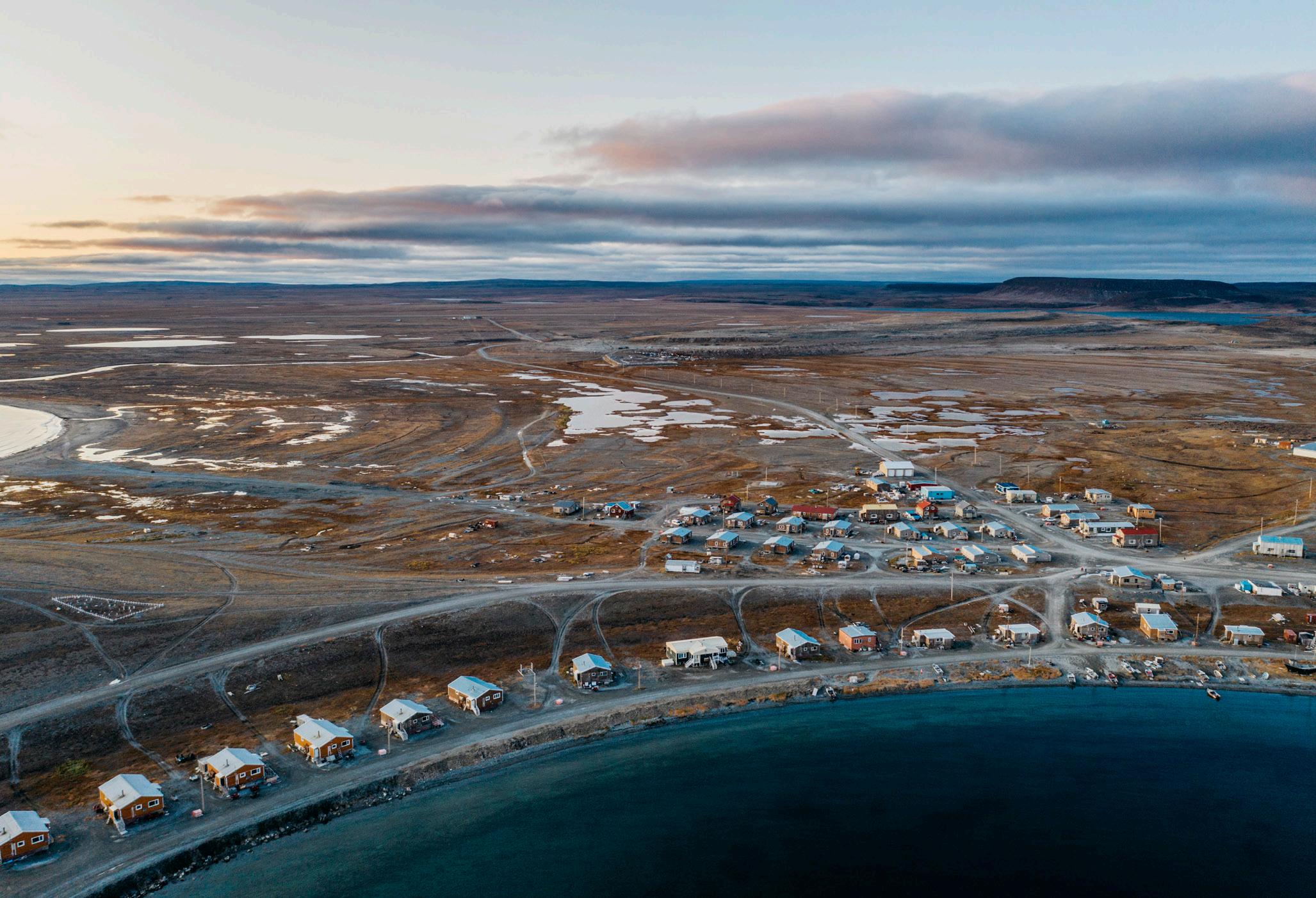
6 minute read
Connected in Ulukhaktok
Unique Internet network ready to launch in community
by Darrell Greer Northern News Services

Years of hard work and training will come to fruition the week of Aug. 14 when the small community of Ulukhaktok goes online with its own community network.
The project was made possible with the aid and backing of the Internet Society, a global non-profit organization with a mission of ensuring that the Internet is for everyone.
Part of achieving that mission is supporting community-led efforts to get fast, affordable and reliable Internet.
Internet Society spokesperson Natalie Campbell said the creation of community networks is, basically, a community developing its own Internet service-provider solution in a way that puts them in the driver’s seat.
She said the approach allows them to develop a solution that meets their own specific needs, rather than having to rely upon what the incumbent telecommunications operator has to offer.
“The Internet Society supports these kinds of solutions in every region of the world, usually through partnerships and technical training, as well as, at times, helping with seed funding and technical equipment,” said Campbell.
“Back in 2018 we hosted an indigenous connectivity summit, which is basically gathering indigenous-owned community-network operators.
“These are people who have solutions on how to promote more indigenous-led community networks, and who believe that Indigenous communities need to have faster, more affordable and reliable Internet.”
Campbell said the summit was held in Inuvik and the society partnered with the Inuvialuit Regional Corp. (IRC) to discuss how it could potentially set-up one of these community networks in Ulukhaktok with its population of about 400.
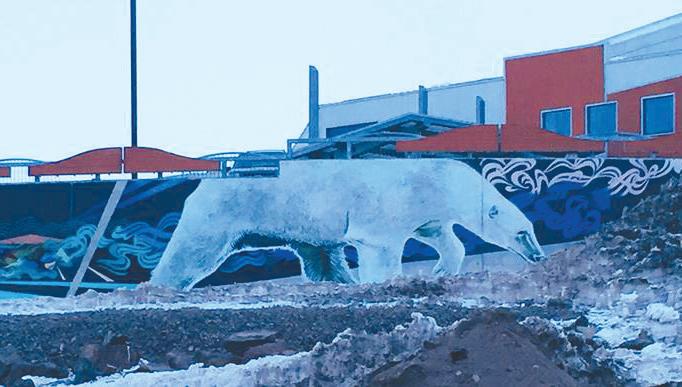
Following that, she said, the society held a community network training session in Ulukhaktok in 2019 .
“The only reason we were able to start this at all was because of the development of these partnerships.
“Partnerships are key in any community network and we had a good one with IRC, and the Hamlet of Ulukhaktok, itself, so folks in the community were really key to help host the technical training we did.”
The Internet Society helped explore different solutions for the community network, such as low-Earth-satellite-orbit solutions.
Additional partner
But, like so much across the globe, everything was, more or less, put on hold when Covid happened with all its restrictions, such as society members being limited in terms of travelling in and out of the community.
Campbell said, this year, the University of Washington was another partner that come into the mix with the project.
She said the network will, in fact, be finished using a low-Earth-orbit-satellite technology.
“If all the technical stuff goes well the week of Aug. 14th, the network will be set up and ready to give access to folks in the community through their cell phones.
“The society won’t have specific numbers on the network’s speed until it completes the final setup.
“Its early research does indicate, however, that it should be faster than the access the community currently has through its incumbent provider.”
Campbell said she was really inspired by the commitment and patience shown by the community of Ulukhaktok.
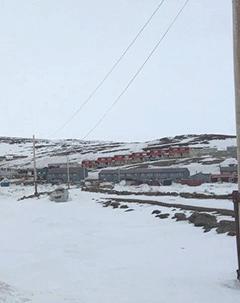
She said communities across the Northwest Territories have heard a lot of promises for cheaper and faster Internet from different companies for a very long time.
“I’m very inspired by their patience to work with us as we looked into these different back-haul solutions, and how we are going to get the Internet access and make it accessible in the community.
“They’ve been determined to find their own solutions and really own this. Covid sucked for everyone and it was especially critical to have Internet access at that time.
“One of the reasons as to why the determination remains, I believe, is because Covid showed everyone around the world, especially those who take it for granted, how critical the Internet is to our daily lives and literal survival.
“It helped keep the determination of everyone involved going in order to get to this initial solution.”
Campbell said what the society anticipates with bandwidth, download speed, etc., is all going to hinge on how the actual deployment goes on the week of the 14th.
She said they have their best guesses, but they’re not going to know until they’re in Ulukhaktok and it actually happens.
“The ISU is really key in making this community network exist, as well as the Ulukhaktok Community Corp. They’re still determining what that business model looks like but we do know that it is going to give free access, and be faster and more reliable that what they currently have.
Continued on Page A13
From Page A12
“When I was up there last, I was really struck by two instances that happened. I was knitting while on the plane and somebody asked me where I had learned to knit and I said I had learned on YouTube.
“She replied by saying that she had to choose between using YouTube and buying groceries.
“I mean, you know there’s a problem but, when people put it in those terms, it’s like oh my God.”
‘Another OMG moment’
Campbell said the second instance involved a young man selling carvings.
She said they were discussing pricing when she told the young man she had no cash.
“I asked him to let me go to whatever bank machine was there.
“He told me it was OK, that he’d sell it cheaper because he needed to pay his Internet bill and I had another OMG moment.”
Campbell said the benefits to having their own system are numerous, including new learning opportunities from sites like YouTube to better connections to educational resources.
She said it can also benefit craftspeople who go from trying to sell their crafts to whomever ends-up in their community, to selling them on the Internet for the prices that their work is actually worth.
“It’s going to be incredible for economic development, creating even more tourism opportunities and opening avenues to share their culture with the world.
“We know when communities get access to the Internet, it’s not just about faster access. It’s about better educational opportunities, better job and entrepreneur opportunities, and better access to telehealth and government E services.
“It’s also about staying connected with friends and loved ones. Social media was all we had during the Covid pandemic lockdown.
“I think it’s going to be pretty epic once the network is deployed, and I look forward to seeing all of the innovative ways that the community comes up with to make the most of it.”
Campbell said the Internet was meant to be open and accessible to all and not have high barriers to access.
She said the community networks are one way to lower those barriers and empower people who want to be able to access the Internet to be able to do so.
“We see examples of these community-led indigenous networks across North America that have done what telecommunication companies promised and failed to do for decades.
“It’s really a beautiful thing to see.

“I can’t underscore enough the importance of partnerships to make this a reality. As well, the persistence and dedication of our partners and the Hamlet of Ulukhaktok to stick with us while we working towards this solution.


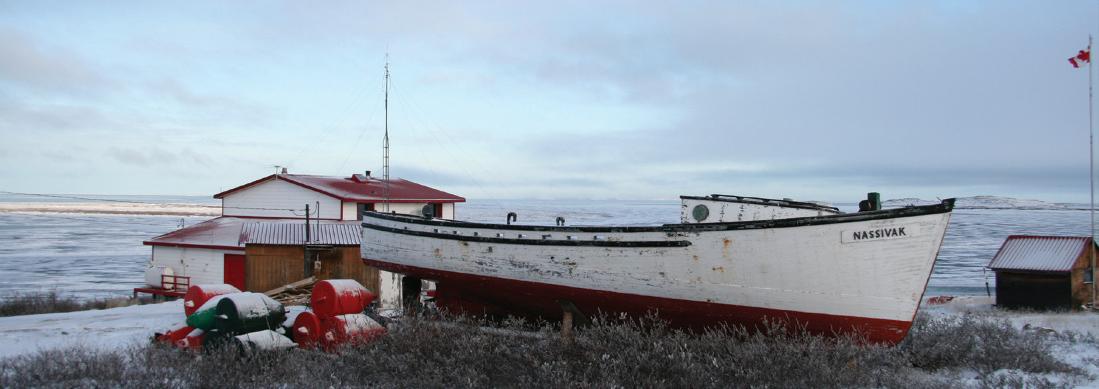
“IRC and the University of Washington were incredible in helping us to get where we are now. I hope we can potentially expand this pilot to even more communities across the Arctic, should we be successful here.”

‘ᐃᓄᐃᑦ
ᐅᖃᐅᓯᐊᓂᒃ ᐱᓯᒪᑎᐊᕋᓱᐊᕐᓂᕐᒥᒃ’
ᐅᖃᖅᐳᖅ ᓴᓂᑭᓗᐊᕐᒥᐅᑕᖅ ᐄᓚ ᒪᕆ ᑲᒡᕕᒃ ᒥᑭᔪᒃ
ᐊᕐᕋᒍ ᐊᓂᒍᖅᓯᒪᕗᖅ ᑐᓂᖅᓴᐃᓚᐅᖅᓯᒪᓪᓗᑎᒃ ᕿᑭᖅᑕᓂᒃᑯᑦ ᐊᕋᒍᑕᒪᑦ ᐊᑐᖅᑕᐅᓲᖑᓕᖅᑐᖅ ᔫ ᐊᑕᒍᑦᑕᓗᒃ ᐃᓄᒃᑎᑐᑦ ᐅᖃᐅᓯᖅ ᐱᓯᒪᑦᑎᐊᕋᓱᐅᕐᓂᖅ
ᓇᓗᓇᐃᑯᑕᕐᒥᒃ ᐊᒻᒪᓗ 12 ᐃᓱᓕᑦᑎᔪᑦ ᐃᓕᓐᓂᐊᖅᑕᒥᓂᒃ ᓄᓇᕗᑦ ᐃᓗᐊᓂ ᑐᓐᓂᖅᓴᖅᑕᐅᓚᐅᖅᐳᑦ.
ᓇᓗᓇᒃᐃᑯᑎ ᐊᑦᑎᖅᑕᐅᓚᐅᖅᐳᖅ ᕿᑭᖅᑕᓂᒃᑯᑦ ᑎᑎᕋᑦᑎᑦ-ᑮᓇᐅᔭᓕᕆᔨᒋᓚᐅᖅᓯᒪᔭᖓ, ᐱᔾᔪᑎᖓ ᖁᕕᐊᓱᖃᑎᖃᕐᓂᖅ ᐃᓕᓐᓂᐊᖅᑐᓂᒃ ᑕᑯᒃᓴᐅᑎᑦᑎᔪᓇᕐᓂᕐᒥᓂᒃ ᐱᔪᒪᓂᕐᒥᓄᑦ ᐃᓄᒃᑎᑐᑦ ᐅᖃᐅᓯᖅ ᐱᓯᒪᑎᐊᕋᓱᐊᕐᓂᕐᒥᒃ.
ᐋᖅᑭᒃᑕᐅᓯᒪᖁᔭᐅᔪᒃᑯᑦ ᓇᓗᓇᐃᑯᑕᖅ ᐃᓚᖃᖅᖢᓂ $2000 ᑮᓇᐅᔭᒃᓴᒥᒃ.
‘ᐅᖃᐅᓯᕋ ᖃᐅᔨᒪᒐᑦᑎᐊᕋᒃᑯ ᐱᑖᖃᑕᐅᕗᖓ, ᐊᓯᐅᔨᓚᐅᖅᓯᒪᔾᔮᖏᖦᖢᒍᓗ ᐅᖃᐅᓯᕋ, ᐊᒻᒪᓗ ᐃᓕᓐᓂᐊᖅᑎᑦᑎᔪᓐᓇᕈᒪ ᓄᑲᖅᖠᐅᓂᖅᓴᐅᔪᓄᑦ ᐊᔪᙱᒃᑯᒪ,’ ᐅᖃᖅᐳᖅ ᓴᓂᑭᓗᐊᕐᒥᐊᑕᖅ ᐄᓚ ᓚᕆ ᑲᕕᒃ ᒥᑭᔪᒃ, ᓂᕈᐊᖅᑕᐅᖃᑕᐅᓯᒪᔪᖅ ᓇᓗᓇᐃᑯᑕᖅᑖᕐᓂᕐᒧᑦ.
ᑲᕕᒃ ᒥᑭᔪᒃ, ᐊᖑᓇᓱᒃᑎᒻᒪᕆᖑᕈᒪᔪᖅ ᐃᓕᓐᓂᐊᖅᑕᒥᓂ ᐃᓱᓕᑦᑎᒐᒥ, ᐅᖃᖅᖢᓂᓗ ᐱᒻᒪᕆᐅᒋᓂᖅᐹᕆᒐᒥᐅᒃ ᓴᐳᑎᔪᒪᓪᓗᓂᐅᒡᓗ ᐃᓄᒃᑎᑐᑦ ᓱᖃᐃᒻᒪ ᐃᓐᓇᐅᔪᑦ ᐃᓕᓐᓂᐊᕆᐊᖅᑎᑕᐅᕙᓚᐅᖅᓯᒪᔪᑦ ᐅᖃᐅᓯᕐᒥᓂᒃ ᐊᓯᐅᔨᓂᑰᖕᒪᑕ.
‘ᐱᒻᒪᕆᐅᖕᒪᑦ ᓲᖃᐃᒻᒪ ᐅᕙᖓᐅᒐᒪ ᐊᒻᒪᓗ ᑖᓐᓇᐅᖏᓇᐅᔭᕈᒪᓪᓗᖓ ᐃᓅᓯᓕᒪᓐᓂᑦ,’
ᐅᖃᖅᐳᖅ. ᐃᓐᓇᖅᐳᑦ ᐃᓕᓐᓂᐊᕆᐊᖅᑎᑕᐅᕙᓚᐅᖅᑐᑦ ᐅᖃᐅᓯᕐᒥᓂᒃ ᐊᓯᐅᔨᓯᒪᖄᑎᕐᒪᑕ, ᐃᓚᖏᑦ ᐊᓯᐅᔨᑦᑎᐊᒻᒪᕆᒃᓯᒪᓪᓗᑎᒃ ᐅᖃᐅᓯᕐᒥᓂᒃ.
‘ᓲᕐᓗ ᐃᓅᓯᒐ ᐊᓯᐅᔨᓪᓗᒍ, ᐱᒻᒪᕆᐅᒋᕙᕋ.’
ᐅᑯᐊ 2023 ᔫ ᐊᑕᒍᑦᑖᓗᒃ ᐃᓄᒃᑎᑐᑦ ᐅᖃᐅᓯᖅ ᐱᓯᒪᑦᑎᐊᕋᓱᐊᕐᓂᖅᒧᑦ
ᓇᓗᓇᐃᑯᑕᕐᒥᑦ ᓵᓚᒃᓴᖅᑐᑦ:
− ᒑᒥ ᐅᖄᓪᓚᓐ, ᐃᒃᐱᐊᕐᔪᒃ
− ᔭᐃᑦ ᐸᓂᓗ, ᑲᖏᖅᖠᓂᖅ
− ᔭᐃᒥᓯ ᖃᐅᓐᓇᖅ, ᐊᐅᔪᐃᑦᑐᖅ

− ᓵᓕᑦ ᐊᖑᒑᑦᑎᐊᖅ, ᐃᒡᓗᓕᒃ

− ᑭᐅᕈᓕᓐ ᐃᖃᓗᒃ, ᐃᖃᓗᐃᑦ
− ᑯᕆᔅᑎᓐ ᑎᒥᓚ, ᑭᒻᒥᕈᑦ
− ᔮᓐ Hᐊᕈᑦ, ᑭᙵᐃᑦ
− ᓅᓕᓐ ᑯᓗᒍᒃᑐ, ᐸᖕᓂᖅᑑ
− ᓲᓯ ᓴᐃᒧᓂ, ᒥᑎᒪᑕᓕᒃ
− ᐊᔅᑕ ᐃᓪᓚᐅᑦ, ᖃᐅᓱᐃᑦᑐᖅ
− ᑯᓘᕆᔭ ᓇᖕᒪᓕᒃ, ᓴᓂᕋᔭᒃ
ᐊᑕᐅᓯᖅ ᓱᓕ 13-ᒋᔭᐅᓪᓗᐊᖅᑐᖅ ᓇᓗᓇᐃᑯᑕᖅᑖᓗᐊᖅᑐᖅ ᕿᑭᖅᑕᕐᔪᐊᕐᓂ
ᐊᕌᒍᒋᔭᑦᑎᓐᓂ ᑐᓂᔭᐅᓂᐊᖅᑐᖅ.
‘ᕿᑭᖅᑕᓂᒃᑯᑦ ᓇᓗᓇᐅᑯᑕᕐᒥᒃ ᐋᕿᒃᓯᓪᓗᑎᒃ ᔫ ᐊᑕᒍᑦᑖᓗᑉ ᐱᓕᕆᐊᕆᕙᓚᐅᖅᑕᓂ
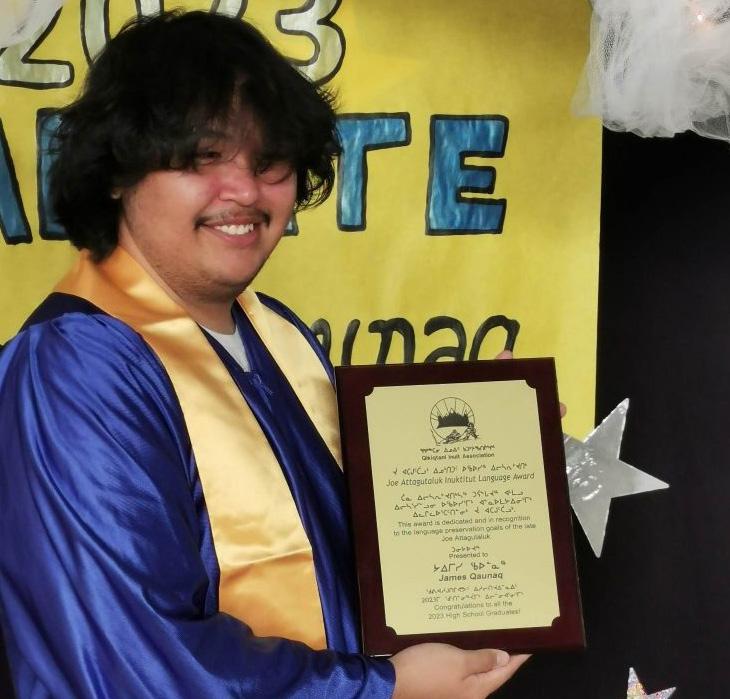
ᐊᒃᓱᕈᖅᖢᓂ ᑕᖃᓚᐅᖅᓯᒪᖏᑦᑐᖅᑎᑐᑦ ᐱᓯᒻᒦᓐᓇᕋᓱᒃᖢᓂ ᐃᓄᒃᑎᑐᑦ ᐅᖃᐅᓯᕐᒥᒃ,’ ᐅᖃᖅᐳᖅ ᕿᑭᖅᑕᓂᒃᑯᑦ ᐃᓱᒪᑕᖓ ᑐᓴᖅᑐᓕᕆᓂᕐᒧᑦ ᕆᐅ Hᐊᑉᑭᓐᔅ. ‘ᓇᓗᓇᐃᑯᑕᖅ
ᕿᓂᓲᖅ ᓇᓗᓇᐃᖅᓯᓂᖃᕈᒪᓪᓗᓂ ᐃᓕᓐᓂᐊᖅᑐᓄᑦ, ᐱᕕᒃᑐᓄᑦ ᑕᐃᒃᑯᓄᖓ ᐃᓄᒃᑎᑐᑦ
ᐅᖃᐅᓯᕐᒥᒃ ᐱᒻᒪᕆᐅᒍᓱᒃᑐᓄᑦ.
ᕿᑭᖅᑕᓂᒃᑯᑦ ᖁᕕᐊᓱᖃᑎᖃᒃᑲᓂᕈᒪᕗᑦ ᐊᕌᒍ ᓯᕗᓪᓕᖅ ᑎᑭᐅᑎᖕᒪᑦ ᔫ ᐊᑕᒍᑦᑖᓗᒃ
ᓇᓗᓇᐃᑯᑕᕐᒥᒃ ᑐᓐᓂᖅᓴᐃᓂᖅ ᐊᒻᒪᓗ ᑲᔪᓯᑎᑕᐅᔪᒪᓪᓗᓂ ᐊᑐᖅᑕᐅᖏᓐᓇᕐᓗᓂ ᑭᖑᒻᒧᑦ.’
ᐊᐅᔪᐃᑦᑐᕐᒥᐅᑕᖅ ᐃᓱᓕᑦᑎᔪᖅ ᐃᓕᓐᓂᐊᖅᑕᒥᓂᒃ ᔭᐃᒥᓯ ᖃᐅᓇᖅ ᐊᔾᔨᓕᐅᖅᑕᐅᕗᖅ ᔫ ᐊᑕᒍᑦᑖᓗᒃ ᐃᓄᒃᑎᑐᑦ ᐅᖃᐅᓯᓕᕆᓂᕐᒧᑦ ᓇᓗᓇᐃᑯᑕᖅᑖᕐᒥᓂᒃ ᑎᒍᒥᐊᖅᖢᓂ. ᖃᐅᓇᖅ ᐊᒻᒪᓗ ᐃᓱᓕᑦᑎᖃᑕᐅᔪᑦ ᓇᓗᓇᐃᑯᑕᖅᑖᖃᑕᐅᒋᓪᓗᑎᒃ ᐊᒻᒪᓗ $2000 ᑮᓇᐅᔭᒃᓴᕐᒥᒃ. ᐊᔨᖁᑎᒋᔭᐅᔪᖅ ᕿᑭᖅᑕᓂ ᐃᓄᐃᑦ ᑲᑐᔨᖃᑎᒌᒃᑯᑦ

